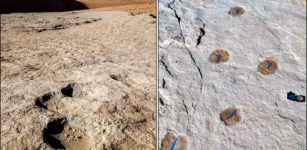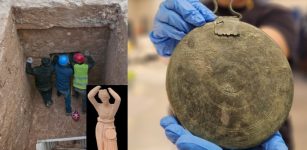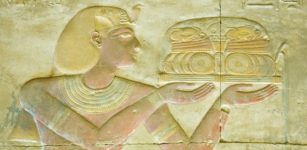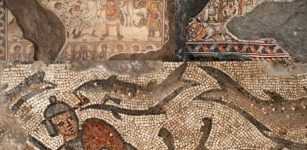Caganer: The Pooping Man Is Part Of The Catalonian Christmas Tradition And Nativity Scene
Ellen Lloyd - AncientPages.com - Most of us would think twice before placing this little pooping guy known as Caganer at home during Christmas. Our friends and family might think we have an odd sense of humor and there seems to be nothing Christian about him at all.
The situation and views are completely different in Catalonia. This can be surprising to some, but Caganer, the pooping man is accepted by the Catholic Church in Catalonia within the areas where the Caganer is popular.
Caganer. Credit: istolethetv - CC BY 2.0 - Right: A Caganer figurine in Barcelona, Spain. Credit: Roeland P. - CC BY 2.0
Caganer is a respected Christmas figure one can find him in all homes in Catalonia. He is a part of the Catalonian Christmas tradition and has been so for a very long time.
The exact origin of the Caganer is unknown, but the tradition has existed since at least the 18th century.
Most people in Catalonia have no idea how Caganer became part of the Christmas tradition, but each house buys a figure every year.
For at least the past two centuries, the traditional nativity scene in Catalonia has been enhanced by a Caganer. The Caganer is never in the front of the nativity scene. That would be a lack of respect. He is often hiding in a corner doing his business whilst the birth of Christ. The name "El Caganer” literally means "the crapper" or "the shitter".
A polite translation of El Caganer would be The Defecator and he is normally dressed in the traditional Catalan peasant clothing of a white shirt, black trousers, and a red faixa and barretina and is often smoking a pipe.
Why Is A Pooping Man Part Of The Nativity Scene?
Originally, El Caganer wasn't a figure in the nativity scene. He was only depicted on tiles, but from the 19th century onward he became popular as a nativity character.
How he entered the nativity scene is uncertain, but according to one theory, this has to do with the fact that Catalans traditionally referred to newborn babies as caganers because they do little else other than eat, sleep and defecate.
Consequently, when visitors came around at Christmas, they would look at the nativity scene and ask their hosts "Have you put in the caganer yet?" referring to the baby Jesus.
Credit: Caganercom - CC BY-SA 3.0
At some point, an imaginative manufacturer of nativity figures must have decided to turn the title character into a nativity model and so the tradition of El Caganer was born.
Another explanation is that El Caganer fertilizes the ground with his feces and so is considered a symbol of prosperity and good luck for the coming year.
There is a legend that if a countryside man did not put a caganer in the nativity scene, he would have a very bad year collecting vegetables,” he said, claiming that the figurine is a symbol of fertility and good fortune.
Attempts To Ban The Caganer Failed
There were some attempts by the government to remove the Caganer from public nativities. In 2005 the local council of Barcelona decided to omit the Caganer from the city’s public nativity scene, it was said the presence of Caganer encouraged bad behavior in a city which has struggled with problems of public urination in the past.
People didn’t like this decision at all and many locals complained about what they saw as an attack on their cultural heritage. In 2006 the caganer was reinstated to his usual place among the wise men, the donkeys, and the angels. It seems that, despite his unverified origins and dubious behavior, the Caganer is more popular than ever and he is definitely here to stay.
Credit: Caganercom - CC BY-SA 3.0
In recent years, it’s possible to buy a Caganer made in the image of a public figure. Christmas markets sell the likes of politicians, soccer players, foreign presidents, rock stars, and royalty.
Needless to say that people find this funny and figures like for example Queen Elizabeth II are popular, but if you don’t want the queen, you can always buy someone else.
Updated on December 15, 2021
Written by Ellen Lloyd – AncientPages.com
Copyright © AncientPages.com All rights reserved. This material may not be published, broadcast, rewritten or redistributed in whole or part without the express written permission of AncientPages.com
Expand for referencesMore From Ancient Pages
-
 Cave 53 In Qumran Region In Judean Desert Reveals More Secrets
Archaeology | Feb 28, 2022
Cave 53 In Qumran Region In Judean Desert Reveals More Secrets
Archaeology | Feb 28, 2022 -
 On This Day In History: Isaac Asimov Creator Of Science Fiction Was Born – On Jan 2, 1920
News | Jan 2, 2017
On This Day In History: Isaac Asimov Creator Of Science Fiction Was Born – On Jan 2, 1920
News | Jan 2, 2017 -
 Ziggurats, Axis Mundi And Strong Connection To Religion In Mesopotamia
Featured Stories | Mar 17, 2021
Ziggurats, Axis Mundi And Strong Connection To Religion In Mesopotamia
Featured Stories | Mar 17, 2021 -
 Once-In-A-Lifetime Find – Ancient Roman and Saxon Cemetery Unearthed In Leeds
Archaeology | Mar 30, 2023
Once-In-A-Lifetime Find – Ancient Roman and Saxon Cemetery Unearthed In Leeds
Archaeology | Mar 30, 2023 -
 On This Day In History: National Foundation Day Celebrated In Japan – On Feb 11, 660 AD
News | Feb 11, 2017
On This Day In History: National Foundation Day Celebrated In Japan – On Feb 11, 660 AD
News | Feb 11, 2017 -
 120,000-Year-Old Human Footprints Discovered In Saudi Arabia
Archaeology | Sep 18, 2020
120,000-Year-Old Human Footprints Discovered In Saudi Arabia
Archaeology | Sep 18, 2020 -
 Did The Great Sphinx Of Giza Have A Twin And Was It Destroyed By A Lightning Strike?
Featured Stories | Dec 23, 2017
Did The Great Sphinx Of Giza Have A Twin And Was It Destroyed By A Lightning Strike?
Featured Stories | Dec 23, 2017 -
 Mystery Of The Marble Lions On The Sacred Island Of Delos Solved?
Archaeology | Oct 12, 2021
Mystery Of The Marble Lions On The Sacred Island Of Delos Solved?
Archaeology | Oct 12, 2021 -
 DNA Study Sheds Light On The Mysterious Picts Of Scotland
DNA | Jul 7, 2023
DNA Study Sheds Light On The Mysterious Picts Of Scotland
DNA | Jul 7, 2023 -
 2,000-Year-Old Stela And ‘Laboratory’ Of Early Maya Writing Found In Guatemala
Archaeology | Mar 15, 2020
2,000-Year-Old Stela And ‘Laboratory’ Of Early Maya Writing Found In Guatemala
Archaeology | Mar 15, 2020 -
 Rare 2,300-Year-Old Tomb Of Greek Courtesan Found In Jerusalem Burial Cave
Archaeology | Sep 28, 2023
Rare 2,300-Year-Old Tomb Of Greek Courtesan Found In Jerusalem Burial Cave
Archaeology | Sep 28, 2023 -
 Could Shipworms Be Destroying The Wreck Of Captain Cook’s Endeavour?
Archaeology | Aug 18, 2022
Could Shipworms Be Destroying The Wreck Of Captain Cook’s Endeavour?
Archaeology | Aug 18, 2022 -
 The City Of David – Why Is It So Controversial?
Biblical Mysteries | Jan 9, 2019
The City Of David – Why Is It So Controversial?
Biblical Mysteries | Jan 9, 2019 -
 Great Viking Fortresses Built By King Harald Bluetooth
Featured Stories | Dec 12, 2022
Great Viking Fortresses Built By King Harald Bluetooth
Featured Stories | Dec 12, 2022 -
 10 Ancient Shipwrecks And Several Underwater Artifacts Found Around The Island Of Kasos
Archaeology | Mar 14, 2024
10 Ancient Shipwrecks And Several Underwater Artifacts Found Around The Island Of Kasos
Archaeology | Mar 14, 2024 -
 On This Day In History: Great Siege of Malta: Ottoman Forces Made Attempt To Conquer Malta And Failed – On May 18, 1565
News | May 18, 2016
On This Day In History: Great Siege of Malta: Ottoman Forces Made Attempt To Conquer Malta And Failed – On May 18, 1565
News | May 18, 2016 -
 Table Manners And First Code Of Correct Behavior Were Introduced In Egypt 2,500 B.C. By Ptahhotep
Ancient History Facts | Oct 26, 2020
Table Manners And First Code Of Correct Behavior Were Introduced In Egypt 2,500 B.C. By Ptahhotep
Ancient History Facts | Oct 26, 2020 -
 First Genetic Map Of People Of Ireland Is Presented By Irish, British And American Researchers
Archaeology | Dec 15, 2017
First Genetic Map Of People Of Ireland Is Presented By Irish, British And American Researchers
Archaeology | Dec 15, 2017 -
 Ancient Coffin Of Priest Psamtik, Son Of Osiris And Five Replicas Of Goddess Maat Sent On Upcoming Expo
Archaeology | Oct 5, 2021
Ancient Coffin Of Priest Psamtik, Son Of Osiris And Five Replicas Of Goddess Maat Sent On Upcoming Expo
Archaeology | Oct 5, 2021 -
 World’s Oldest Mosaics Of Biblical Jonah And The Whale Discovered
Archaeology | Jul 23, 2017
World’s Oldest Mosaics Of Biblical Jonah And The Whale Discovered
Archaeology | Jul 23, 2017



